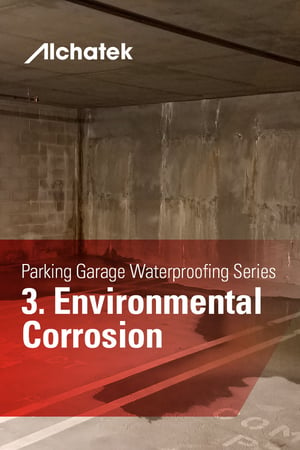
 Environmental corrosion poses a significant threat to the longevity and safety of below-grade parking garages. Elements like salt, chemicals from car exhaust, and even groundwater can have a corrosive effect on the concrete and metal components of these structures. Over time, this corrosion can weaken the garage's structural integrity, leading to costly repairs and safety risks.
Environmental corrosion poses a significant threat to the longevity and safety of below-grade parking garages. Elements like salt, chemicals from car exhaust, and even groundwater can have a corrosive effect on the concrete and metal components of these structures. Over time, this corrosion can weaken the garage's structural integrity, leading to costly repairs and safety risks.
Polyurethane Grout
Polyurethane grout offers a robust solution to this problem. When properly applied by a skilled contractor in a leak seal context, this material can act as an effective barrier against corrosive elements. It seals cracks, joints, and other vulnerable points in the concrete, preventing water and other corrosive substances from penetrating the structure.
When selecting a contractor, it's crucial to choose one with expertise in applying polyurethane grout. This ensures that the application will be done correctly, providing maximum protection against environmental corrosion.
Cost Considerations and Long-Term Value
While the initial cost of hiring a contractor to apply polyurethane grout may seem high, it's essential to consider the long-term value. Here are some points to ponder:
- Reduced Repair Costs: By preventing corrosion, polyurethane grout can significantly reduce the need for future repairs, offering long-term cost savings.
- Increased Lifespan: Effective corrosion prevention can extend the lifespan of the parking garage, delaying the need for more extensive renovations or even replacement.
- Safety: Corrosion can weaken structural elements, posing a safety risk. Polyurethane grout helps maintain the structural integrity of the garage, thereby enhancing safety.
- Asset Value: A well-maintained, corrosion-free parking garage is an asset that can increase the overall value of a property.
Complementing Polyurethane Grout with Other Preventative Measures
While polyurethane grout is a powerful tool in the fight against corrosion, it's most effective when used as part of a broader corrosion prevention strategy. Other preventative measures can include:
- Ventilation Systems: Proper ventilation can reduce the accumulation of corrosive elements like car exhaust.
- Regular Cleaning: Routine cleaning can remove corrosive substances from the garage's surfaces, reducing their impact.
- Coatings and Sealants: Specialized coatings can offer additional protection against corrosion. Discuss with your contractor how these can be used in conjunction with polyurethane grout for maximum effectiveness.
Ensuring Ongoing Effectiveness
Corrosion prevention is not a one-time task but an ongoing responsibility. Regular inspections should be scheduled to assess the effectiveness of the polyurethane grout and other preventative measures. Any signs of new corrosion should be addressed promptly to maintain the integrity of the structure.
The Importance of a Comprehensive Corrosion Prevention Strategy
Environmental corrosion is a formidable challenge that can significantly impact the longevity and safety of below-grade parking garages. Polyurethane grout offers an effective solution, sealing vulnerable points and acting as a barrier against corrosive elements. However, the key to long-term success lies in the quality of the application and its integration into a comprehensive corrosion prevention strategy.




 Below-grade parking garages are particularly susceptible to drainage issues, given their sub-surface location. These challenges can manifest in various ways, from structural damage to safety hazards for users. Effective water management becomes crucial in mitigating these issues.
Below-grade parking garages are particularly susceptible to drainage issues, given their sub-surface location. These challenges can manifest in various ways, from structural damage to safety hazards for users. Effective water management becomes crucial in mitigating these issues.
 Below-grade parking garages serve as essential components of urban infrastructure. They offer convenient parking solutions, especially in densely populated areas where surface parking is limited. However, these subterranean structures are particularly susceptible to water leaks, which can severely compromise their structural integrity. A compromised structure not only poses safety risks but also leads to costly repairs and decreased property value.
Below-grade parking garages serve as essential components of urban infrastructure. They offer convenient parking solutions, especially in densely populated areas where surface parking is limited. However, these subterranean structures are particularly susceptible to water leaks, which can severely compromise their structural integrity. A compromised structure not only poses safety risks but also leads to costly repairs and decreased property value.
 You've now gained valuable insights into the world of driveway concrete leveling, understanding the issues caused by sunken slabs, the options for repair, and how to choose the right path for your home. As you ponder your next steps, consider this important aspect: the expertise and assistance you need to get your driveway back to its prime condition.
You've now gained valuable insights into the world of driveway concrete leveling, understanding the issues caused by sunken slabs, the options for repair, and how to choose the right path for your home. As you ponder your next steps, consider this important aspect: the expertise and assistance you need to get your driveway back to its prime condition.

 When hiring a company to level sunken driveway concrete with polyurethane, homeowners should look for certain qualifications and ask key questions. This helps verify the contractor has the right expertise to tackle the project. By selecting a reliable, experienced professional, homeowners can feel confident about the outcome.
When hiring a company to level sunken driveway concrete with polyurethane, homeowners should look for certain qualifications and ask key questions. This helps verify the contractor has the right expertise to tackle the project. By selecting a reliable, experienced professional, homeowners can feel confident about the outcome.
 When it comes to concrete leveling, homeowners may wonder whether polyurethane or mudjacking is the better method. Both can lift and stabilize sunken slabs without having to demolish and replace the driveway. However, there are some key differences between these two common repair techniques.
When it comes to concrete leveling, homeowners may wonder whether polyurethane or mudjacking is the better method. Both can lift and stabilize sunken slabs without having to demolish and replace the driveway. However, there are some key differences between these two common repair techniques.
 Should you repair sunken slabs or replace the driveway completely? There are pros and cons to each approach.
Should you repair sunken slabs or replace the driveway completely? There are pros and cons to each approach.
 It's a scene that many homeowners dread: glancing out the window one day to discover large sunken areas in your once-smooth concrete driveway. These uneven sagging sections seem to appear out of nowhere, but in reality, are the result of a very common problem.
It's a scene that many homeowners dread: glancing out the window one day to discover large sunken areas in your once-smooth concrete driveway. These uneven sagging sections seem to appear out of nowhere, but in reality, are the result of a very common problem.
 As specialists in waterproofing solutions, the Alchatek support team understands the unique needs facing public aquariums. Leaky exhibits and tanks can disrupt the visitor experience and require timely repair. Alchatek is here to help aquariums tackle these challenges.
As specialists in waterproofing solutions, the Alchatek support team understands the unique needs facing public aquariums. Leaky exhibits and tanks can disrupt the visitor experience and require timely repair. Alchatek is here to help aquariums tackle these challenges.
 Public aquariums, with their mesmerizing exhibits and diverse marine life, are remarkable institutions that captivate visitors worldwide. However, behind the scenes, ensuring the longevity of the seals created by polyurethane grouts is a crucial aspect of maintaining these aquatic wonders. In this segment of our series on enhancing aquarium sustainability with polyurethane grouts, we explore the critical factor of seal longevity and its profound impact on maintenance schedules.
Public aquariums, with their mesmerizing exhibits and diverse marine life, are remarkable institutions that captivate visitors worldwide. However, behind the scenes, ensuring the longevity of the seals created by polyurethane grouts is a crucial aspect of maintaining these aquatic wonders. In this segment of our series on enhancing aquarium sustainability with polyurethane grouts, we explore the critical factor of seal longevity and its profound impact on maintenance schedules.